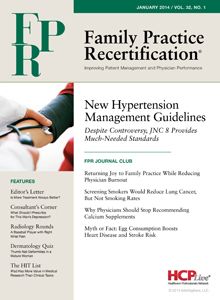Publication
Article
Returning Joy to Family Practice While Reducing Physician Burnout
Author(s):
In light of mounting physician stress and worsening burnout, one study offers a roadmap to returning "joy" to clinical practice.
Frank J. Domino, MD
Review
Sinsky CA, et al. In search of joy in practice: A report of 23 high-functioning primary care practices. Ann Fam Med. 2013;11(3):272-78. http://www.annfammed.org/content/11/3/272.full.
Study Methods
This study attempted to identify issues that increase the risk of physician burnout and then find practical solutions to lower that risk. The authors studied 23 “high-performing” practices known to support both quality of care and physician work-life satisfaction. The practices represented different geographical regions and included small practices, large integrated delivery systems, academic medical centers, Veterans’ Affairs offices, and federally qualified healthcare centers.
At least 1 of the authors visited each of the sites, shadowing physicians and their teams for a day and then meeting with administrators and clinical leaders. In addition to follow-up emails, 2 further “virtual visits” were conducted via telephone. A semi-structured site visit questionnaire was used to record outcomes.
Results and Outcomes
Frequent issues noted in the site visit records comprised of “unplanned visits with over-full agendas by patients,” inadequate clinician support to meet the demand of patient care, too much time spent documenting and complying with administrative and regulatory requirements, computerized technology that “pushes more work to the physician,” and teams functioning poorly, which complicate rather than simplify work.
Conclusion
The observed solutions to those commonly faced problems included:
1. Reduced work through pre-visit planning and pre-appointment lab tests.
High-functioning sites found pre-visit planning and pre-visit lab testing reduced the work volume, saved time, and improved care. This process involves reviewing the tests and referrals that need to be done in advance of upcoming appointments, which allows the visit to focus on outcomes rather than questions.
2. Adding capacity by sharing care among the team.
The goal of improving access for patients who need same-day care was met by sharing some of the workload with medical assistants, nurses, and health coaches, in addition to social workers, behaviorists, nutritionists, and pharmacists. To boost quality measures, many sites transformed the role of medical assistants to review medications, identify office visit agenda, send out health-monitoring reminders to patients, administer immunizations, and book tests.
Other solutions included standing orders registered nurses could use to diagnose and treat simple conditions like pharyngitis, conjunctivitis, ear pain, head lice, sexually transmitted infections (STIs), and uncomplicated urinary tract infections (UTIs). Inclusion of social workers, psychologists, and other allied health providers in patient care allowed physicians to focus more on the management of conditions in which they displayed expertise and produced excellence.
3. Eliminating time-consuming documentation.
Six of the sites used trained staff to “scribe” physicians’ notes, enter orders, prepare after-visit summaries, and reinforce the plan with the patient. For example, a nurse or medical assistant would first complete an expanded rooming protocol where an agenda was identified and subsequently shared with a physician. The assistant would then record notes while the physician examined the patient. At 1 site, this process increased the average daily visit from 21 to 28 visits per day, thereby improving both access and continuity with an additional boost in revenue.
4. Re-engineering prescription workflow.
Physicians who prescribed 12- to 15-month supplies of chronic medications covered patients through their next annual comprehensive care visit and “avoid(ed) repeating the same work multiple times throughout the year."
5. Reducing unnecessary physician work through inbox management.
Though “tasking” electronic messages help address patient concerns in an asynchronous fashion, the volume of such tasks can be overwhelming. Filtering those tasks through intermediate care personnel resulted in decreased work for the physician and improved happiness for all parts of the office, including the patient.
Verbal messaging directed to a medical assistant or nurse also reduced the volume of inbox issues by filtering out normal test results, prescription renewals, and requests that could be managed by protocol. Only messages that required a higher level of attention were passed to the physician. This strategy reduced the number of tasks sent to physicians, which formerly might have resulted in a response to a task with a question.
6. Improving team communication through co-locations, huddles, and team meetings.
Medical team co-location allowed for more efficient communication and less time spent looking for staff members. Having the physician and medical assistant sit side by side led to significant communication improvement at 1 site. Other mechanisms included weekly clinical staff meetings to review data and plan for upcoming patient care.
7. Refining team functioning through systems planning and workflow mapping.
Workflow mapping involves observing how members of a team perform their jobs. Moving the workflow to a more efficient or less complex system led to improved efficiency and less patient risk. One practice identified and eliminated waste through value stream mapping and process standardization. By using this technique, a patient visit was mapped from a workflow perspective, a root cause analysis was conducted, and then counter measures were developed and executed with a post-implementation evaluation.
Commentary
There are many challenges in attracting medical students to family practice. One of the most significant barriers is the amount of time and energy spent not on patient care, but on the completion of forms and other clerical tasks, which lowers job satisfaction and increases the risk of physician burnout.
This study “set out to search for joy in practice,” and what it found were pockets of high professional satisfaction in a new paradigm of clinical practice. The processes and solutions implemented among the 23 sites studied are attainable for most offices. Practices with stable, well-trained teams that met regularly and worked together in close proximity every day had improved efficiency and joy in care. Standardized workflows with greater levels of clinical support personnel saved time, made care less chaotic, and met patients’ needs more effectively. Face-to-face verbal communication was often more effective, efficient, and enjoyable than circulating asynchronous electronic messaging.
The challenge for physicians who wish to follow these suggestions include changing responsibility for certain aspects of patient care. Physicians are often trained academically and socially to take full responsibility for patient problem-solving. Therefore, learning to share responsibility with other team members requires a change in physician mindset and trust. A registered nurse who diagnoses and treats STIs in a typical office setting might address the acute management of the problem, but unless the nurse is highly trained, he or she may not provide the necessary additional risk assessment, HIV testing, and prevention counseling.
Of all the suggested changes, the use of a scribe and team-based order entry was a common theme among practices and providers who felt the greatest degree of joy. Both recordkeeping and order entry are considerably correlated with provider frustration and burnout — a matter that has become even more concerning as physicians’ notes lengthen to meet documentation requirements for billing. Fortunately, scribing is a powerful tool for reducing this burden and freeing up more time to focus on direct patient care and relationship building.
Family practice is once again in flux. Keeping current with health recommendations is a full-time job, and providing care that follows new guidelines only adds to the challenge. Taking a 21st-century approach to the delivery of care has resulted in mounting physician stress and worsening burnout. To return “joy” to clinical practice, innovations must be attempted and evaluated in office settings, and this study offers some insight on where to begin.
About the Author
Frank J. Domino, MD, is Professor and Pre-Doctoral Education Director for the Department of Family Medicine and Community Health at the University of Massachusetts Medical School in Worcester, MA. Domino is Editor-in-Chief of the 5-Minute Clinical Consult series (Lippincott Williams & Wilkins). Additionally, he is Co-Author and Editor of the Epocrates LAB database, and author and editor to the MedPearls smartphone app. He presents nationally for the American Academy of Family Medicine and serves as the Family Physician Representative to the Harvard Medical School’s Continuing Education Committee.






